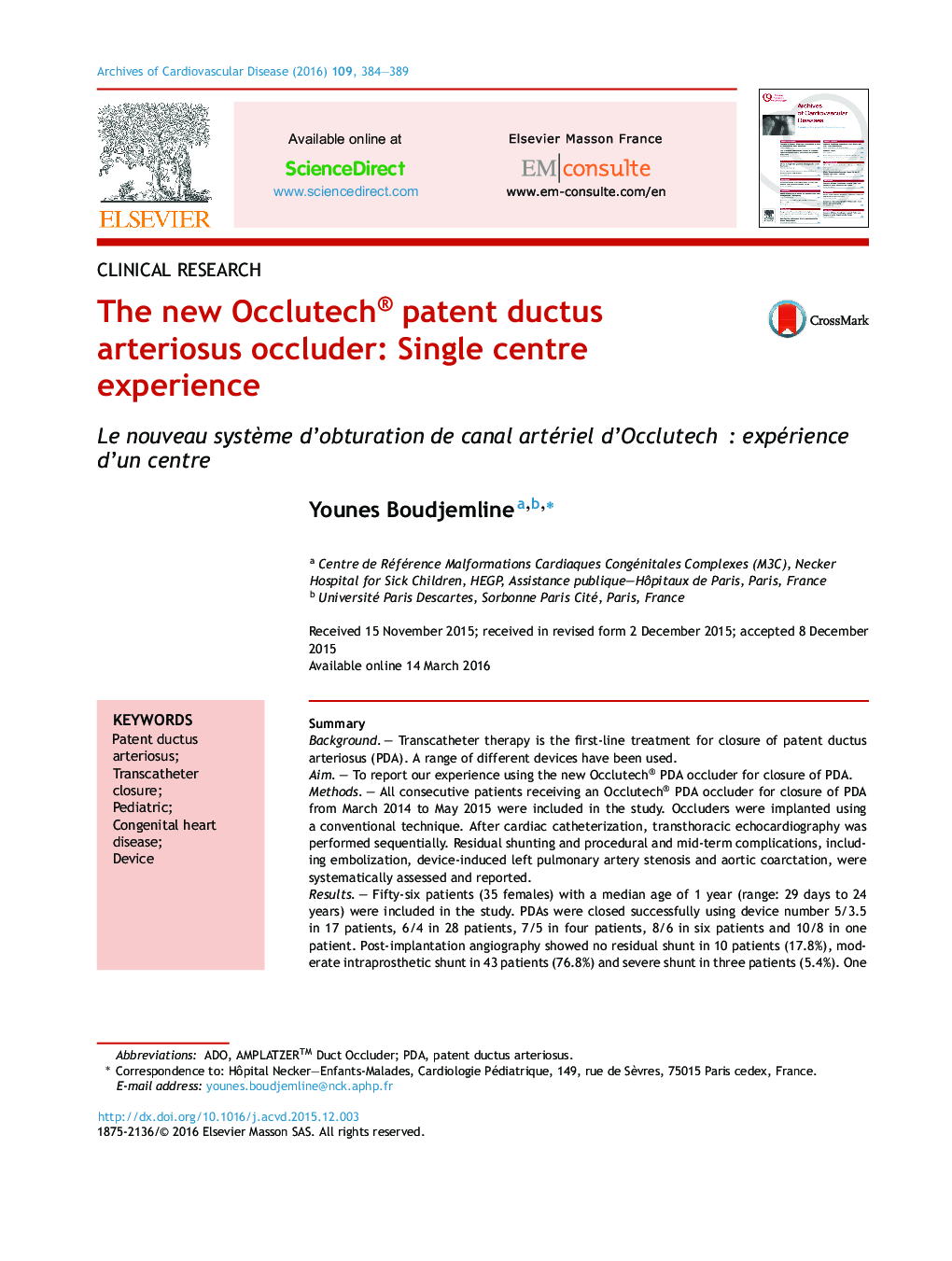| کد مقاله | کد نشریه | سال انتشار | مقاله انگلیسی | نسخه تمام متن |
|---|---|---|---|---|
| 2888636 | 1574333 | 2016 | 6 صفحه PDF | دانلود رایگان |

SummaryBackgroundTranscatheter therapy is the first-line treatment for closure of patent ductus arteriosus (PDA). A range of different devices have been used.AimTo report our experience using the new Occlutech® PDA occluder for closure of PDA.MethodsAll consecutive patients receiving an Occlutech® PDA occluder for closure of PDA from March 2014 to May 2015 were included in the study. Occluders were implanted using a conventional technique. After cardiac catheterization, transthoracic echocardiography was performed sequentially. Residual shunting and procedural and mid-term complications, including embolization, device-induced left pulmonary artery stenosis and aortic coarctation, were systematically assessed and reported.ResultsFifty-six patients (35 females) with a median age of 1 year (range: 29 days to 24 years) were included in the study. PDAs were closed successfully using device number 5/3.5 in 17 patients, 6/4 in 28 patients, 7/5 in four patients, 8/6 in six patients and 10/8 in one patient. Post-implantation angiography showed no residual shunt in 10 patients (17.8%), moderate intraprosthetic shunt in 43 patients (76.8%) and severe shunt in three patients (5.4%). One device embolized in the right pulmonary artery 1 hour after successful closure; the device was retrieved surgically after unsuccessful snaring. After a mean follow-up of 10 months (range: 3–17.8 months), no residual shunt or device-related complications were noted.ConclusionThe new Occlutech® PDA occluder allows safe and efficient PDA closure, similar to existing devices.
RésuméContexteLe traitement percutané est le traitement de première ligne pour la fermeture d’un canal artériel persistant (PDA). Divers dispositifs sont utilisés.ObjectifNous rapportons les résultats de l’utilisation du nouveau système de fermeture Occlutech®.MéthodesTous les patients consécutifs ayant reçu ce dispositif de mars 2014 à mai 2015 ont été inclus dans cette étude. Les dispositifs ont été implantés selon la technique habituelle. Au décours, des contrôles échographiques ont été réalisées à intervalle régulier à la recherche de complications (shunt résiduel, embolisation, néocoarctation, sténose de l’artère pulmonaire gauche, etc.).RésultatsCinquante-six patients (35 filles) avec un âge médian d’un an (29 jours à 24 ans) ont été inclus. Les canaux artériels ont été occlus avec succès en utilisant des prothèses 5/3,5, 6/4, 7/5, 8/6 et 10/8 respectivement dans 17, 28, 4, 6 et 1 cas. Les angiographies post-procédurales ont montré l’absence de shunt chez 10 patients (17,8 %), la présence d’un shunt modérée intraprothétique chez 43 (76,8 %) et sévère chez 3 (5,4 %). Une embolisation dans l’artère pulmonaire droite a été déplorée une heure après son implantation. Le dispositif a été retiré chirurgicalement après échec du retrait percutané. Après un suivi moyen de 10 mois (3 à 17,8 mois), aucun shunt résiduel n’est à déplorer. Aucune complication secondaire n’a été retrouvée.ConclusionLa nouvelle prothèse Occlutech® de fermeture permet de fermer des canaux artériels avec une efficacité et un risque similaires aux prothèses existantes.
Journal: Archives of Cardiovascular Diseases - Volume 109, Issues 6–7, June–July 2016, Pages 384–389